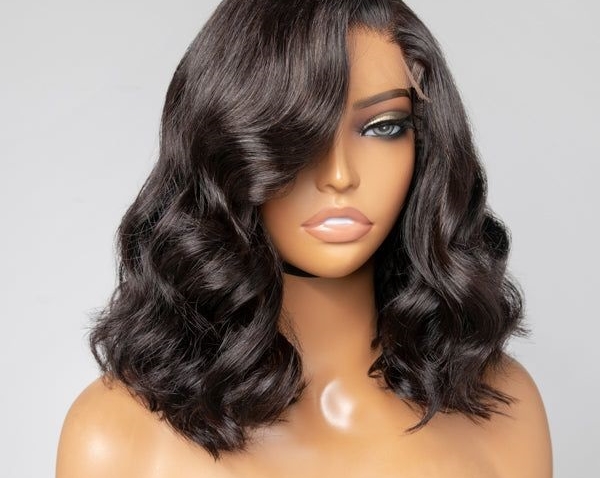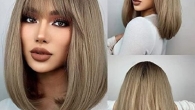
What to Wash Synthetic Wigs With: A Comprehensive Guide
Owning a synthetic wig is a fantastic way to experiment with different hairstyles without committing to permanent changes. However, proper care is essential to maintain its appearance and longevity. One crucial aspect is choosing the right cleaning products. This guide will delve into the best options for washing synthetic wigs and provide expert tips for optimal care.
Understanding Synthetic Wig Fibers
Before we dive into cleaning products, it’s essential to understand the nature of synthetic wig fibers. Unlike human hair, synthetic fibers are made from materials like nylon, acrylic, or polyester. These fibers have specific care requirements to prevent damage and maintain their style.
The Importance of Gentle Cleaning
Synthetic wigs are delicate and require gentle cleaning to prevent tangling, matting, and color fading. Harsh shampoos and conditioners can strip the fibers of their natural oils, leading to dryness and frizz.
Best Shampoos for Synthetic Wigs
When selecting a shampoo for your synthetic wig, look for products specifically designed for synthetic hair. These shampoos are formulated with gentle cleansers that remove dirt and oil without stripping the fibers.

- Avoid sulfate-based shampoos: Sulfates are harsh detergents that can damage synthetic fibers.
- Opt for wig-specific shampoos: These products are tailored to the unique needs of synthetic hair.
- Consider using a gentle baby shampoo: Baby shampoo can be a suitable alternative if you can’t find a wig-specific product.
Conditioners for Synthetic Wigs
Conditioning is essential for maintaining the softness and shine of your synthetic wig. Choose a conditioner specifically formulated for synthetic hair to hydrate and detangle the fibers.
- Look for leave-in conditioners: These products provide continuous moisture and help prevent frizz.
- Avoid heavy conditioners: Thick conditioners can weigh down synthetic fibers and create a greasy appearance.
- Deep condition regularly: Deep conditioning treatments can restore moisture and revitalize your wig.
DIY Hair Care Solutions for Synthetic Wigs
If you prefer natural ingredients, you can create DIY hair care solutions for your synthetic wig.
- Apple cider vinegar rinse: Diluted apple cider vinegar can help remove product buildup and balance the scalp.
- Aloe vera gel: Apply aloe vera gel to the wig as a leave-in conditioner for added moisture.
- Avoid using essential oils: Essential oils can damage synthetic fibers.
How to Wash Your Synthetic Wig
Follow these steps for a gentle and effective wig wash:
- Detangle the wig: Gently brush or comb through the wig to remove tangles before washing.
- Fill a sink with lukewarm water: Avoid using hot water, as it can damage the fibers.
- Add shampoo: Pour a small amount of wig shampoo into the water and create a gentle lather.
- Soak the wig: Immerse the wig in the soapy water and gently swish it around.
- Rinse thoroughly: Remove all shampoo residue by rinsing the wig with lukewarm water.
- Apply conditioner: Apply a small amount of wig conditioner to the ends and gently work it through the fibers.
- Rinse again: Remove any excess conditioner with lukewarm water.
- Air dry: Place the wig on a wig stand to air dry completely. Avoid using heat styling tools.
Caring for Your Synthetic Wig Between Washes
To prolong the life of your synthetic wig, follow these tips:
- Store properly: Keep your wig in a cool, dry place away from direct sunlight.
- Avoid heat styling: Excessive heat can damage synthetic fibers.
- Handle with care: Be gentle when putting on, removing, and styling your wig.
- Regularly detangle: Use a wide-tooth comb or wig brush to prevent tangles.
Styling Your Synthetic Wig: Tips and Tricks
While synthetic wigs come pre-styled, there’s always room for a little customization. However, it’s crucial to remember that synthetic fibers can be damaged by heat, so traditional styling tools are out of the question.
Types of Wig Caps
There are several types of wig caps available to cater to different needs and preferences.
- Nylon Wig Caps: These are the most common type, offering a snug fit and preventing hair from showing through.
- Mesh Wig Caps: Breathable and comfortable, these caps allow for airflow and are ideal for sensitive scalps.
- Velcro Wig Caps: Equipped with a Velcro closure for a customizable fit, these caps are suitable for various head sizes.
- Silicone Wig Caps: Offering a non-slip grip, these caps are perfect for securing wigs in place.
- Lace Front Wig Caps: Designed for lace front wigs, these caps create a natural hairline.
Choosing the Right Wig Cap
Selecting the perfect wig cap depends on factors such as your hair type, wig style, and personal comfort.

- Hair Type: If you have short or thin hair, a nylon cap might suffice. For longer or thicker hair, a mesh or Velcro cap might be more suitable.
- Wig Style: Lace front wigs often require lace front wig caps for a seamless appearance.
- Comfort: Consider factors like breathability, fit, and material when choosing a wig cap.
- Scalp Sensitivity: For sensitive scalps, opt for soft, breathable materials like mesh or bamboo.
How to Wear a Wig Cap
Wearing a wig cap is simple:
- Prepare your hair: Smooth down your hair as much as possible to create a smooth base.
- Put on the wig cap: Ensure it fits snugly but comfortably.
- Adjust the wig: Position your wig over the wig cap and secure it according to the wig’s fastening method.
Styling Products for Synthetic Wigs
Just like with washing, specific products are designed for synthetic wigs. These products help maintain the wig’s shape and prevent frizz.
- Wig-specific styling products: Look for mousses, gels, and sprays designed for synthetic hair.
- Avoid alcohol-based products: Alcohol can dry out synthetic fibers.
- Consider using hairspray lightly: A light coat of hairspray can help hold styles in place.
Styling Techniques for Synthetic Wigs
Here are some gentle styling techniques to transform your synthetic wig:
- Wig Caps: Using a wig cap can help secure the wig in place and create a smoother base for styling.
- Styling with Your Hands: You can create waves, curls, or straight styles by gently shaping the wig with your hands.
- Wig Styling Tools: Some specialized wig styling tools, like wig rollers or curlers, can help achieve different looks.
- Steam Styling: Carefully using a steamer can help loosen curls or create new styles.
Avoiding Heat Damage
It’s essential to avoid using hot styling tools on synthetic wigs. Heat can cause irreversible damage to the fibers, ruining the wig.
- Cold water setting: If you must use a curling iron or straightener, use the coldest setting possible and only for a short time.
- Air drying: The safest way to dry your wig is by air drying it on a wig stand.
Maintaining Your Synthetic Wig’s Style
To prolong your wig’s style, follow these tips:

- Gentle brushing: Use a wide-tooth comb or a wig brush to detangle gently.
- Proper storage: Store your wig on a wig stand to maintain its shape.
- Avoid excessive manipulation: Frequent restyling can damage the fibers.
- Regular cleaning: Keep your wig clean to prevent product buildup and maintain its style.
Keep Your Synthetic Wig Looking Its Best
By following these guidelines and using the right products, you can keep your synthetic wig looking its best. Remember, gentle care is key to maintaining the beauty and longevity of your wig.
By following these guidelines and using the right products, you can keep your synthetic wig looking its best. Remember, gentle care is key to maintaining the beauty and longevity of your wig.
Additional Tips:
- Frequency of washing: While it might be tempting to wash your wig often, excessive washing can shorten its lifespan. Aim to wash it every 6-8 wears or when it starts to look dull.
- Storage: When not in use, store your wig on a wig stand to maintain its shape. Avoid storing it in plastic bags as this can trap moisture and lead to mildew.
- Protect from heat: Keep your wig away from direct sunlight, heat sources, and humidity. These elements can damage the synthetic fibers.
- Be gentle with styling: Avoid excessive brushing or combing, as this can cause tangles and damage. Use a wide-tooth comb or a wig brush specifically designed for synthetic hair.
- Regular inspections: Check your wig for any signs of damage, such as fraying or tangles. Address these issues promptly to prevent further problems.
By incorporating these additional tips into your wig care routine, you can ensure that your synthetic wig remains in excellent condition for a long time.












Leave a Reply